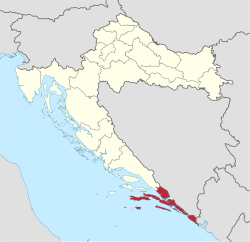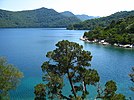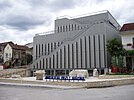
Back مقاطعة دوبروفنيك-نيريتفا Arabic Дуброўніцка-Нерэтванская жупанія BE-X-OLD Дубровнишко-неретванска жупания Bulgarian Dubrovačko-neretvanska županija BS Comtat de Dubrovnik-Neretva Catalan Dubrovačko-Neretvanska Županija CEB Dubrovnicko-neretvanská župa Czech Dubrovnik-Neretva distrikt Danish Gespanschaft Dubrovnik-Neretva German Επαρχία Ντούμπροβνικ-Νέρετβα Greek
Dubrovnik-Neretva County
Dubrovačko-neretvanska županija | |
|---|---|
 Dubrovnik-Neretva County within Croatia | |
| Country | Croatia |
| County seat | Dubrovnik |
| Government | |
| • Župan | Nikola Dobroslavić (HDZ) |
| • Assembly | 41 members |
| Area | |
| • Total | 1,781 km2 (688 sq mi) |
| Population (2021)[2] | |
| • Total | 115,564 |
| • Density | 65/km2 (170/sq mi) |
| Area code | 020 |
| ISO 3166 code | HR-19 |
| HDI (2019) | 0.859[3] very high · 4th |
| Website | edubrovnik.org |
The Dubrovnik-Neretva County (pronounced [dǔbroːʋniːk-něreːtʋa]; Croatian: Dubrovačko-neretvanska županija, pronounced [dǔbroʋat͡ʃko-nerěːtʋanskaː ʒupǎnija]) is the southernmost county of Croatia. The county seat is Dubrovnik and other large towns are Korčula, Metković, Opuzen and Ploče. The Municipality of Neum, which belongs to neighbouring Bosnia and Herzegovina, divides the county in two parts which are connected only by the Pelješac Bridge. The southern part of the county consists of Dubrovnik and the surrounding area, including the Pelješac peninsula, and the islands of Korčula, Lastovo, Mljet, Šipan, Lopud and Koločep. The northern part of the county includes the Neretva Delta, the Baćina lakes north of Ploče, and a swath of hinterland near the southernmost slopes of Biokovo and around the hill of Rujnica. The northern part of the Mljet island is a national park. The Lastovo archipelago is a designated nature park. The southernmost tip of the county is the Prevlaka peninsula at the border with Montenegro. It is the only Croatian county that borders Montenegro.
Although the 9 kilometres-long stretch of coast belonging to Neum effectively makes the southern part of the county an exclave (disconnecting it from mainland Croatia) it is still connected with the rest of the country via the Pelješac Bridge. Road traffic going to and from Dubrovnik through Neum is usually less subject to customs controls in order to reduce the traffic congestion. The road connecting Dubrovnik to the rest of the country via Neum has one lane per direction and bus lines passing through Neum often make rest stops there so that passengers can take advantage of lower Bosnian taxes and purchase tobacco and alcoholic beverages as they tend to be cheaper there.
- ^ Ostroški, Ljiljana, ed. (December 2015). Statistički ljetopis Republike Hrvatske 2015 [Statistical Yearbook of the Republic of Croatia 2015] (PDF). Statistical Yearbook of the Republic of Croatia (in Croatian and English). Vol. 47. Zagreb: Croatian Bureau of Statistics. p. 62. ISSN 1333-3305. Retrieved 27 December 2015.
- ^ Cite error: The named reference
census2021was invoked but never defined (see the help page). - ^ "Sub-national HDI - Area Database - Global Data Lab". hdi.globaldatalab.org. Retrieved 2021-07-19.
© MMXXIII Rich X Search. We shall prevail. All rights reserved. Rich X Search










